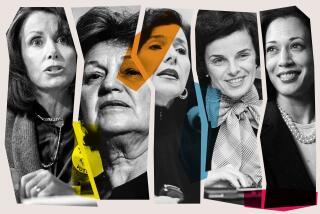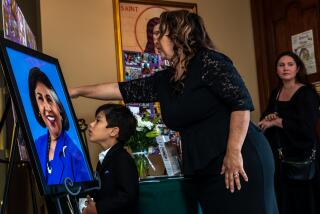In Praise of History’s Super Women
- Share via
Eve “would’ve burned her bra if she’d had one.” So asserts Varla Ventura, author of “Sheroes,” a celebration of 200 women from Susan B. Anthony to Xena who “changed the world for us by blazing trails, breaking down barriers, and empowering other women to do the same.”
First off, Ventura wants to get one thing straight: “Women heroes” doesn’t do justice to these “bold, brash (and absolutely unabashed) superwomen.” Neither does “heroine.”
“Let’s get shero into Webster’s Dictionary, Scrabble, the collective consciousness and, most importantly, the common parlance!” Ventura pleads. To that end, she includes in her book a form letter to be signed and sent to Merriam-Webster by those who support the idea.
“Sheroes” (Conari Press paperback, $16.95) pays tribute to centuries of uppity women: the mythical (the Amazon nation), the memorable (sportSheroes, scholarly and scientific sheroes, eco sheroes and musical sheroes, among them) and the madcap.
The latter includes Poker Alice Ivers, a cigar-smoking, gun-toting woman of the Wild West who, confronting a cheating card dealer one night in Pecos, let the pot grow to $5,000, then held her gun to his head and took his money, shouting: “I don’t mind a cheat. It’s a clumsy cheat I can’t stand!”
“Sheroes come in every imaginable shape, size and color, and manifest their sheroism in infinite ways,” writes Ventura, noting that through the years, women have triumphed over everything from witch burnings to stiletto heels.
There was Phung Thi Chinh, a formidable Vietnamese who in AD 39 helped lead a revolt against China, pausing in mid-rebellion to give birth, then resuming the fight, with her baby bound to her back. And the equally formidable Annie Smith Peck, a 19th century classical scholar and noted mountain climber who once planted a “Votes for Women!” banner atop a Peruvian peak. She was still climbing at 84.
All of the famous names are here, but the most intriguing vignettes are about such lesser-knowns as Anne Hutchinson, who was banned from the Massachusetts colony in 1637 for holding theological salons in which she advocated a personal relationship with God, rather than obedience to the church doctrine embraced by the (male) clergy. She and five of her children were later killed by Indians.
Who was the first woman to run for president? That was Belva Ann Bennett McNall Lockwood, a pioneering lawyer who ran in 1884 on a platform advocating votes for women, peace and temperance, but who lost to Grover Cleveland. Who introduced “Hound Dog,” Elvis’ signature song? That was a black female blues singer, the late Willie Mae “Big Mama” Thornton.
The author devotes a chapter to fictional sheroes such as “Get Smart’s” Agent 99, “Star Trek’s” Lt. Uhura and Batgirl. Not to mention Nancy Drew, created in the ‘30s. “For generations of women now in adulthood,” Ventura observes, Drew “represented virtually the only fictional model of a girl who was extremely competent, physically active, and didn’t need any males to rescue her.”
Alas, Ventura observes, even in 1998, many women achievers remain invisible in the annals of history. As cases in point, she asks the reader to identify (1) Junko Tabei, (2) Sally Louisa Tompkins and (3) Gerti Cori.
Not exactly household names. Tabei was the first woman to climb Mt. Everest, a housewife who led an all-woman Japanese team to the top on May 16, 1975. Tompkins was the only woman officer in the Confederate Army. And Cori was the first woman doctor to win a Nobel Prize, in 1947.
More to Read
Sign up for our Book Club newsletter
Get the latest news, events and more from the Los Angeles Times Book Club, and help us get L.A. reading and talking.
You may occasionally receive promotional content from the Los Angeles Times.









